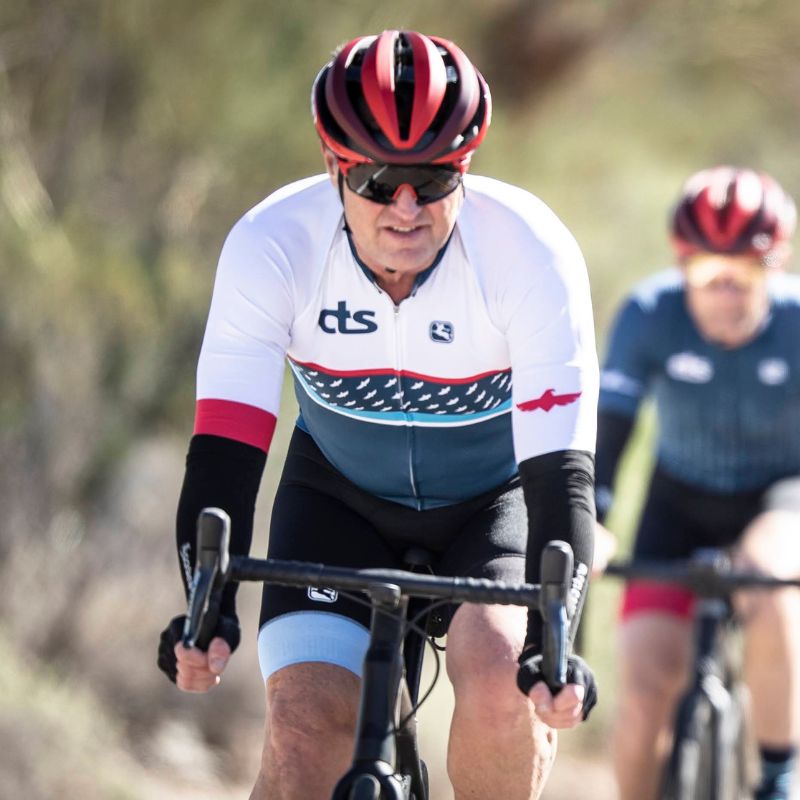4 Keys to Effective Training in Hot Weather
By Chris Carmichael
In 40-plus years of cycling, I’ve never experienced heat like I did climbing through the Pyrenees mountains when I rode with team 7-Eleven in the 1986 Tour de France… or the first three stages of the 2013 Amgen Tour of California. There’s not a spot of shade anywhere, the narrow canyons offer no breeze and the sun bakes the rock walls, the road, and the riders. I felt like my shoes were on fire and I was breathing through a hair dryer.
Heat is the ultimate enemy for an endurance athlete, because after a point, the hotter you get, the slower you’ll go. Part of the problem is that your body generates heat when you exercise, and there’s absolutely no way to avoid it—it’s the primary by-product of physical activity. Only a small portion of the energy liberated from food is used for mechanical work, such as walking or pedaling. The rest radiates from your body as excess heat, which can be a big problem when it’s hot outside. Fortunately, with some planning and attention to detail, dangerously hot days won’t slow you down, and you’ll be able to continue to maximize your training and racing.
Expose Yourself Consistency is a key to acclimating to hot, humid weather. Active exposure, such moderate-intensity cycling, leads to faster and greater adaptations than passive exposure, such as sitting in a sauna or un-air-conditioned house. Chances are if you’ve been riding all summer, your body has already made the key adaptations of increasing blood plasma volume (to produce more sweat) and beginning to sweat earlier and over more of your body. Acclimating typically takes two weeks of consistent heat riding. While you don’t need to ride every day in high temperatures, when you’re trying to acclimate, don’t go more than two or three days between hot training sessions.
Staying hydrated and well fed is also critical to the process of temperature acclimation, and it’s important to note that it’s totally ineffective to restrict liquid intake purposely in an attempt to teach the body to perform well without it. Not only does it not work, it’s dangerous, and you’re better off supporting your body’s natural adaptations with plenty of fluids.
Pick Your Time Riding in the morning or evening to avoid the heat of the day falls into the “no s—t” category of advice, but there are other cooler times to ride, such as in the rain or soon after a thunderstorm. Training in the rain also offers the bonus of gaining the wet-riding skills and confidence you’ll need when the sky opens up at your next race or century. If the mercury is scaring you away from hard intervals, which generate the most body heat, consider doing your intervals in an air-conditioned room with fans before going outside to complete the rest of your training volume at a steady, moderate intensity. Personally, I’d ride outside at midnight rather than spend more time indoors in the summer, but maybe that’s just me.
Feel Stronger in 6 Weeks — No Matter Your Age
Climbs feel steeper? Recovery slower?
You’re not done getting faster — you just need a smarter plan.
The 6-Week Masters Power Build Coaching Program is designed for cyclists 50+ who want to boost power, recover faster, and ride stronger — all with expert 1:1 coaching.
- Personalized 6-Week Training Plan
- 1:1 Coaching + TrainingPeaks Premium
- Mobility & Strength Bonus Guides
💪 Guarantee: Stronger or free.
Start your 6-week journey for $149Warm Up To Cool Off A thorough warm up is vital in the heat because it lets your evaporative cooling system get up to speed before you do. Jumping right into a hard effort spikes your body temperature before you’ve started sweating enough for your system to begin cooling you. One of the benefits of greater fitness and acclimation is that your body begins sweating earlier–it’s much easier to keep a body cool than to use sweat to cool it once it’s overheated. To stay on the safe side, start workouts off slowly when it’s hot.
► Free Cycling Training Assessment Quiz
Take our free 2-minute quiz to discover how effective your training is and get recommendations for how you can improve.
Get Wet When it’s really hot, in my days and even now, Tour de France riders grab bottles from fans, but not to drink. Drinking water comes from the team car, but the water from the fans is perfect for cooling off. Does dumping water on your head and clothing help? Yes. Cyclists have an edge over other athletes in this type of cooling because we move fast enough to have constant airflow over the wet clothing. On heat alert days, carry extra bottles or stop and refill often to ensure you have enough liquid to keep your body wet. If you overheat to the point of heat illness, find a way to immerse yourself in cool or cold water, the best way to reduce core temperature, according to the American College of Sports Medicine. Jump in a creek, stand in a sprinkler, use a hose—whatever you have to do to completely soak yourself. The wetter you get, the more quickly you’ll dissipate heat.
(Adapted from Chris Carmichael's column in Bicycling Magazine.)
► FREE Mini-Course: Learn How to Maximize Your Limited Training Time
Learn step-by-step how to overcome limited training time and get faster. Walk away with a personalized plan to increase your performance.
"*" indicates required fields


Comments 1
Pingback: Back to cycling in Japan’s heat | Travels on various bikes ;-)